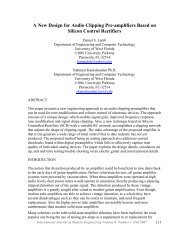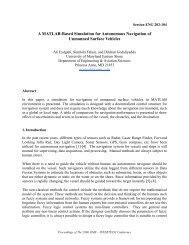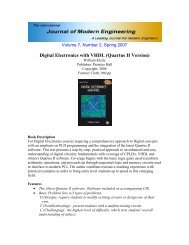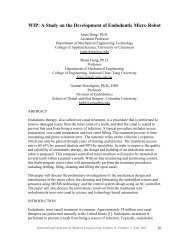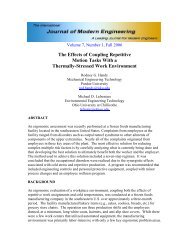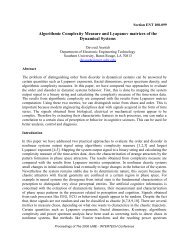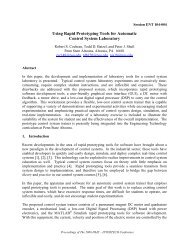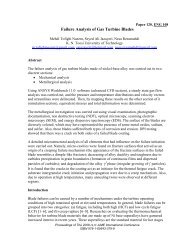Design and Testing of a Permanent Magnet Axial Flux Wind ... - IJME
Design and Testing of a Permanent Magnet Axial Flux Wind ... - IJME
Design and Testing of a Permanent Magnet Axial Flux Wind ... - IJME
You also want an ePaper? Increase the reach of your titles
YUMPU automatically turns print PDFs into web optimized ePapers that Google loves.
where N is the number <strong>of</strong> turns per coil, i is the current in each individual conductor in the<br />
coil; c x is the coil conductor bundle width in the circumferential direction; <strong>and</strong> α c is the<br />
average coil span in electrical radians. The Fourier coefficients corresponding to the current<br />
sheet density can be plugged directly into equation (7) to calculate the flux density due to the<br />
armature conductors.<br />
Note that the coil span may vary with radius for certain types <strong>of</strong> coil design. For this reason,<br />
the armature reaction is evaluated for several radial slices, as described previously, to<br />
determine the armature reaction field at various radii. The total flux density due to armature<br />
reaction for a single slice is the sum <strong>of</strong> the space harmonic components:<br />
B ( x)<br />
∑ B ( x)<br />
(10)<br />
arm<br />
=<br />
n=<br />
1<br />
n−arm<br />
Finally, the net airgap flux density per radial slice can be calculated using superposition by<br />
adding the contributions <strong>of</strong> both magnet sides (equations 1 <strong>and</strong> 2) with the armature reaction<br />
contribution (equation 10).<br />
3.3. Computation <strong>of</strong> Generator Parameters<br />
Once the net field solution is obtained (due to rotor field <strong>and</strong> armature reaction), other<br />
quantities <strong>of</strong> interest may be evaluated, such as back emf, the machine torque, <strong>and</strong> torque<br />
ripple. With this approach, it is possible to analyze the entire electro-mechanical system for<br />
any specified operating condition <strong>and</strong> simulating rotation, as well as to quickly calculate<br />
magnetic fields, torques, armature currents, <strong>and</strong> voltages.<br />
To determine the back emf, the flux linking each coil can be determined from the solution for<br />
net airgap flux density. The magnetic flux linking a coil in a single radial slice <strong>of</strong> the machine<br />
is a function <strong>of</strong> the rotor angle θ <strong>and</strong> can be expressed as<br />
slice<br />
( θ ) = N ∫∫ B ⋅<br />
λ dS , (11)<br />
S<br />
where S is the surface inside the coil for the radial slice under consideration. Numerically,<br />
this is calculated using the cross-sectional area enclosed by the coil slice. The total flux<br />
linking the entire coil is then determined by summing the flux linking each radial slice,<br />
( θ ) λ ( θ )<br />
λ ∑ . (12)<br />
coil<br />
= slices<br />
slice<br />
1<br />
By carrying out the magnetic field calculations in a time-stepping fashion with a changing<br />
rotor angle θ , the flux linking each coil can be determined at each time step. The induced<br />
emf in the coil is determined directly by Faraday’s Law:<br />
e<br />
coil<br />
∆ coil<br />
t =<br />
∆t<br />
λ<br />
( ) . (13)<br />
Proceedings <strong>of</strong> The 2008 IAJC-<strong>IJME</strong> International Conference<br />
ISBN 978-1-60643-379-9



